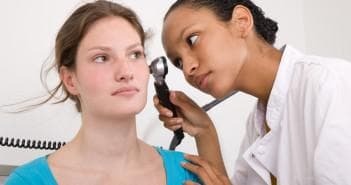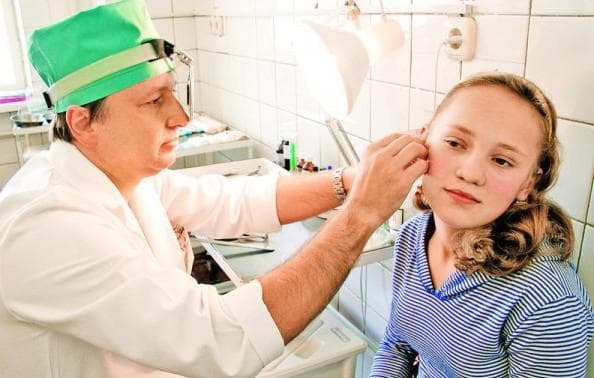
Ear inflammation or otitis is a viral disease that occurs as a complication of ARVI.Depending on the location of the otolaryngologists, there are otitis media of the external, middle and inner ear. Most often, patients are confronted with the easiest version of it - the external one, which, with timely diagnosis and properly performed treatment, can be quickly docked. But sometimes the infection penetrates deeper and affects the tympanic membrane and Eustachian tube, as a result of which acute hemorrhagic, or bullous, otitis may occur.
Contents of
- 1 Symptoms of the disease and its diagnosis
- 2 Treatment in children
- 3 Treatment in adults
Symptoms of the disease and its diagnosis

How to determine the development of the disease? Outwardly its manifestations are no different from ordinary otitis. The patient is concerned about the following symptoms:
- pain in the ear;
- one-sided hearing loss;
- purulent discharge;
- temperature increase.
You can also see the signs of purulent otitis media. In the event that the infection has spread to the vestibular apparatus, more serious symptoms are noted - gait disturbances, movement uncertainty, dizziness, nausea, vomiting. If the lesion affects the facial or optic nerve, asymmetry of the facial muscles and horizontal one-sided nystagmus( pupillary shaking) from the side of the ear can be observed.
The video tells about bullous otitis:
Diagnosis is performed by an otolaryngologist after a patient's examination, otoscopy( examination with the help of special tools) and laboratory test results.
When examined in the ear cavity, blisters or bullae, characteristic for this disease, are found, filled with a sacred liquid. They have a round shape, the size of the millet grains to a small pea and painted in a purple-red color.
The number of them, as a rule, is limited to two or three. The rupture of bulla is accompanied by the outflow from the ear of the sacred. Outbreaks of the disease are often fixed in epidemics of influenza, for which it can still be called influenza otitis.
Treatment in children
If a child complains of ear pain, hearing impairment, it is necessary to consult a doctor urgently. This is not necessarily an otitis, especially bullous - often pain can be triggered by other factors: boils, foreign objects, mechanical damage. Another thing, if the listed symptoms are accompanied by an increase in body temperature - in this case there is an acute inflammatory process.
The video tells about bullous otitis in children:
Diagnosis is complicated when it comes to children under one year who are not yet able to determine the nature of the pain, indicate the location of its location and even more clearly complain. What to do in this case? Signs of ear inflammation in infants are:
- frequent or constant crying;
- involuntary movements of the head;
- rubbing the ear with the hand;
- refusal to eat;
- discharge from the ear;
- congestion and redness of the nose.
Pain, as a rule, increases by night, the child's state of health deteriorates accordingly. Categorically one should not engage in self-medication, drop something into the auditory canal without consulting a doctor, and even more so try to conduct the diagnosis yourself with help of improvised objects.
Given that otitis media is fraught with such life-threatening complications as meningitis and sepsis, procrastination is fraught with serious consequences.
Self-medication is also dangerous because in the case of damage to the tympanic membrane, various oil drops, reaching the auditory nerve, can cause irreparable damage to it and provoke hearing loss. Do not forget about the side effects: substances such as levomycetin and boric acid can cause shock, convulsions, diarrhea, nausea and vomiting. Therefore, all treatment should be carried out only in accordance with the appointment of a doctor and under his supervision. Here you can read more about the purulent otitis in the baby.
On the photo - doctor's examination: 
Before providing qualified medical care, parents can help their child by clearing his nasal passages with a special rubber pear. To facilitate the cleansing of the nose, it is recommended to dip a little saline solution into the nose two to three minutes before the procedure( 1 teaspoon per 200 ml of water).After this, you should drip drops( in the case of children up to the year the drug should not be vasoconstrictive). Here you can see which drops are used to treat otitis media. Here are described ear drops for otitis in children.
Regardless of the origin of otitis, you can not heat your ear with either special lamps or wrapping your head with shawls and scarves. This contributes to the emergence and spread of a purulent process.
Treatment of bullous otitis in a child is performed in an ENT hospital using antibiotics such as Amoxiclav, Ceftriaxone, Cefuroxime. Here you can read more about what antibiotics to treat otitis. Depending on the condition and age of the patient, they can be administered orally, intramuscularly or intravenously( using a dropper).To lower the temperature used Panadol, Efferalgan, Kalpol, Nurofen. Contraindicated for this purpose Analgin and Aspirin.
If necessary( if bullous otitis is accompanied by a purulent otitis media of the middle ear), the surgeon can offer to make a puncture of the tympanic membrane to facilitate the release of pus. To be afraid of this does not follow - the eardrum is capable of recovering on its own without any additional manipulation, but the child will become much calmer by reducing pain. Moreover - in many cases of middle otitis membranes burst itself, without waiting for the intervention of the doctor.

Read how to cure a child for 3 years.
Find out what to do if a cold starts to fill your ear.
Reviews about the use of azithromycin in angina: http: //prolor.ru/g/lechenie/ azitromicin-pri-angine.html.
Treatment in adults
In adults, the disease is usually easier, and if it is docked in time, does not leave any complications. In case of neglected conditions and the onset of a purulent discharge, drainage of the tympanic cavity is performed, otherwise local and general therapy with antibiotics( reference to otitis treatment with antibiotics in adults), anti-edema and antihistamines, steroids and topical corticosteroids( Anauran, Sofredex).Continuous hearing control is also necessary.
Even in cases where bullous otitis is caused by a viral infection, against the background of a general weakening of immunity and an inflammatory process, bacterial infection can join it. This possibility is necessarily taken into account by the doctors when prescribing therapy.
In rare cases( with a large amount of pus, the appearance of signs of a destructive process), surgery on the mastoid process may be necessary.
On the video - more information about bullous otitis:
Within the framework of this article, one can not but touch a disease such as bullous megritis. Its symptoms are similar to those seen with otitis media, but in most cases the disease is complicated by sensorimotor deafness. Bullous meringitis is distinguished by the location of bullae - they concentrate mainly on the tympanic membrane, which causes severe pain, up to loss of appetite and sleep. Therefore, the initial task of the otolaryngologist is to exclude this disease.
